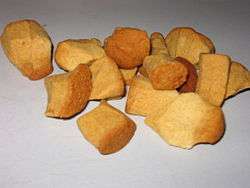Pepernoot
A pepernoot (Dutch pronunciation: ['peːpərˌnoːt] (![]()
![]()
 | |
| Course | Treat |
|---|---|
| Place of origin | Netherlands |
| Main ingredients | |
Pepernoot, however, looks identical to a second German Pfeffernüsse. This second German Pfeffernüsse traveled to the US many years ago, and is still made in the US. This second German Pfeffernüsse includes cardomom, cloves, cinnamon, pepper, butter, vinegar, eggs, brown syrup, and flour.
They are light brown, square shaped, and made from the same ingredients as taai-taai: rye flour, sugar and anise, and sometimes also cinnamon, and clove. They are fairly chewy, though they harden gradually when exposed to the air.
A particularly distinct custom associated with pepernoten is throwing them in handfuls through the room so children can look for them. Originally this is an ancient fertility symbol not unlike throwing rice at a marriage like a farmer sowing seeds. In ancient times, parents of newborns would place one or two carrots underneath the infant's pillow. They believed Sinterklaas would then come and bless the child by showering the infant with "pepernoten".
See also
- Kruidnoten are often confused with pepernoten.[1][2]
- Pfeffernüsse
References
- "Pepernoten / kruidnoten: Noem je het bekende strooigoed nu pepernoten of kruidnoten? Of is daar een verschil tussen?" (in Dutch). onzetaal.nl. Retrieved 19 November 2011.
- "Pepernoten of kruidnoten?" (in Dutch). Radio Nederland Wereldomroep. 21 November 2010. Archived from the original on 28 November 2011. Retrieved 19 November 2011.